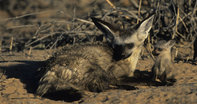
Name
Bat-eared fox [Otocyon megalotis]Appearance
The main feature of the bat-eared fox is its large ears, which have black fur on the outside with white hair on the inside. Their large ears are ideal for hearing prey below the ground in the bushveld of South Africa.
They have a fluffy silver-gray coat with a black-tipped bushy tail. They have long, pointed muzzles that are black on top and white underneath. These small foxes stand 300 mm high from the shoulders and are 800 mm long. They weigh between 3-5 kg.
Bat-eared Fox Diet
The tiny teeth of the bat-eared fox limit them to a diet of fruit, small rodents and insects found in South Africa. They mainly feed on harvester termites and forage in family groups.Bat-eared Fox Breeding
The breeding season in South Africa for the bat-eared fox occurs between late October and early January. They have a gestation period of 60 days. Litters consist of between 2 – 5 cubs and they are weaned for about 10 weeks. The bat-eared fox reaches sexual maturity when it is two years old.Bat-eared Fox Behaviour
Mainly nocturnal, the bat-eared fox prefers to sleep in its burrow during the heat of the day in South Africa. When the pups are in the den, the male will stand guard while the female forages for food.
The bat-eared fox lives among short-grass and open shrub environments which allows it to easily spot predators and food. To escape predators, the bat-eared fox either escapes into its den or takes cover in tall grass or a thick bush.
 Learning about the mammals of South Africa is now so much easier for all South Africans - SouthAfrica.co.za is an excellent source of inform...
Learning about the mammals of South Africa is now so much easier for all South Africans - SouthAfrica.co.za is an excellent source of inform...